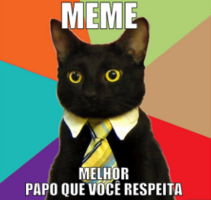Design em fluxo: processos e temporalidades dos memes de internet
Na passagem do século XX para o século XXI, vimos a internet se expandir mais rapidamente que outros sistemas de comunicação. O fácil acesso a ferramentas de edição de texto e imagem, por sua vez, popularizou processos de escrita visual. O modelo de difusão um-para-todos, característico dos grandes veículos de mídia, foi impactado pelo novo modelo todos-todos, característico da web colaborativa, com seus fóruns, blogs e mídias sociais. As pessoas, no papel de consumidoras, produtoras e propagadoras de conteúdos digitais, encontraram nas interfaces fluidas e dinâmicas das mídias sociais espaço propício para a proliferação de peças de mídia. Dentre estas peças, imagens conhecidas como memes de internet espalharam-se pelos diálogos em rede. Compartilhados de pessoa em pessoa, memes tornaram-se uma linguagem em si, através da qual é possível expressar-se diante das mais diversas questões cotidianas, sociais e políticas. Nesta pesquisa, investigo a produção e o consumo de memes de internet compartilhados em mídias sociais a partir de temas de grande repercussão nacional. Busco processos e temporalidades associados a estas soluções flexíveis e alteráveis que, fruto do design vernacular, ou mesmo profissional, espalham-se rapidamente por interfaces digitais. Em seus fluxos, que se dão em torno da construção coletiva de identidades meméticas, são formados conjuntos de peças de mídia em constante mutação. Enquanto registro vivo de fluxos de produção e compartilhamento de ideias, memes de internet constituem uma base consistente, vasta e acessível, para análise de uma nova linguagem narrativa que emerge da cultura digital.
In the transition from the twentieth to the twenty-first century, we witnessed the internet expand faster than any other previous communication system. Easy access to text and image editing tools, in turn, popularized visual writing processes. The one-to-many broadcasting model, so characteristic of major media outlets, was impacted by the new many-to-many model, characteristic of the collaborative web with its online boards, blogs, and social media. People, as consumers, producers and propagators of digital content, found in the fluid and dynamic interfaces of social media a conducive space for the proliferation of digital media pieces. Among these pieces are the images known as internet memes, which have spread through networked dialogues. Shared from person to person, memes became a language in and of itself, and through them people can express themselves before the most diverse daily, social and political issues. In this research, I investigate the production and consumption of internet memes that have been shared in social media after events of great national repercussion. I seek for the processes and temporalities associated with these flexible and alterable solutions that, as a result of vernacular or even professional design, can rapidly spread through digital interfaces. In their flows, which take place around the collective construction of memetic identities, sets of media pieces in constant mutation are formed. As a living record of production flows and idea sharing, internet memes provide a consistent, vast and accessible basis for analyzing a new narrative language that emerges from the digital culture.
